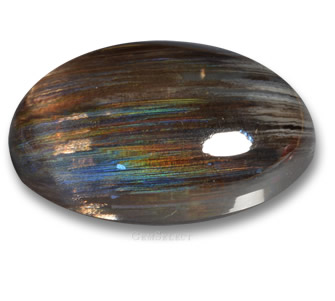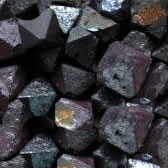Rainbow Scapolite Gemstones
 |
| Oval Rainbow Scapolite Cabochon |
Scapolite is a sodium calcium aluminum silicate with a hardness of 5.5 to 6 on the Mohs scale. It is named from the Greek for "stick," since its tetragonal crystals grow in columns. Scapolite has a vitreous luster and specimens displaying chatoyancy or the cat's eye effect are sometimes found.
"Rainbow scapolite" is a trade name given to an even rarer variety of scapolite which contains attractive iridescent inclusions, often composed of magnetite. Iridescence is a multicolored optical phenomenon that is prized in several colored gemstones, including fire agate, ammolite, rainbow pyrite and labradorite (known as labradorescence). In rainbow scapolite, the iridescent color can be seen within the gemstone, as the gem is looked at from different angles under focused light (such as a flashlight); under daylight, the inclusions of rainbow scapolite appear brownish. Like cat's eye scapolite, rainbow scapolite gemstones are usually cut en cabochon to properly display their attractive inclusions, though in rare cases, they have been seen faceted. Expert lapidaries will orient the stone so that the most iridescence will be seen when looking through the top of the stone.
 |
| Magnetite Crystals |
The iridescent inclusions in rainbow scapolite may be sparse or dense, like in rutile quartz. In fact, the inclusions were first assumed to be composed of rutile, but were later revealed by the GIA to be made of magnetite. These inclusions may exhibit two or more colors, or even the full spectrum of colors. The inclusions appear as needle-like fibers and the iridescent sheen is due to thin layers of magnetite crystals which reflect the light.
One form of magnetite was known as "lodestone" in the past and used as a magnetic material. Magnetite was named by Wilhelm Karl von Haidinger in 1845. Its name comes from the site where it was found; Magnesia in Greece. Magnetite is a magnetic member of the spinel group, and is believed by some to possess beneficial magnetic properties. Therefore, magnetite is used in crystal healing jewelry. Additionally, scapolite is thought by crystal healing believers to be a stone of achievement and problem solving.
The body color of rainbow scapolite can appear white, brown, greenish or dark-gray. Therefore, it is a perfect jewelry gemstone for both men and women. To show rainbow scapolite gems at their best, they should be able to catch the light so that the iridescence can be seen and appreciated. The best jewelry application for this is in a cabochon ring or a bracelet. Alternatively, matching cabochons would make an attractive pair of pendant earrings. Rainbow scapolite can also be fashioned into a necklace pendant, though the iridescence will not be as visible as in a ring or bracelet, which catch the light more often due to hand and arm movement.
For those who are interested in rare and gemstones with intriguing optical phenomena, rainbow scapolite is a stone to consider and enjoy as part of a unique gemstone jewelry collection.
|
